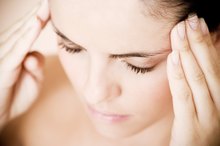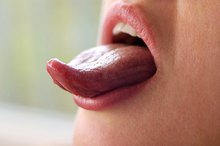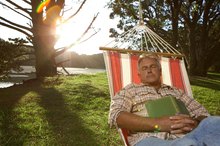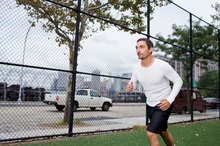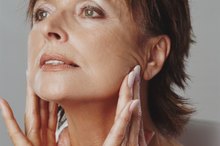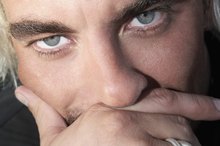Facial Signs of Stroke
Facial paralysis can occur after a stroke, according to MedlinePlus 2. In fact, several facial symptoms may result from a stroke. Early recognition of the facial signs of stroke can be key to stroke recovery. According to the National Institute of Neurological Disorders and Stroke (NINDS), a person suspected of having a stroke should get to the hospital as soon as possible for specialized intervention 1.
Facial Droop
One of the most obvious facial signs of stroke is droop. MedlinePlus reports that because strokes often affect the muscles on one side of the body, this droop usually occurs only on one side of the face. A person who has had a stroke may appear expressionless on one side of his face and normal on the other side. The affected side of the face may also appear droopy due to decreased muscle tone.
- One of the most obvious facial signs of stroke is droop.
- MedlinePlus reports that because strokes often affect the muscles on one side of the body, this droop usually occurs only on one side of the face.
Crooked Smile
Blood Clot in Brain Symptoms
Learn More
A person who has had a stroke may have difficulty smiling. Because one side of the face is often affected while the other is not, only one corner of the person’s mouth may raise into a smile. Due to one-sided facial paralysis, the other side of the mouth may barely move or may not move at all 2.
Uneven Eyebrows
Because facial paralysis resulting from a stroke is usually one-sided, a person may not be able to raise both eyebrows at the same time 2. Depending on the severity of the stroke, one eyebrow may even appear to be lower on the face, as the forehead muscles on that side may have low tone.
Closed Eyelid
Facial Exercises for Stroke Patients
Learn More
In addition to a facial droop and uneven eyebrows, a person who has had a stroke may have difficulty controlling one of her eyelids. It is common for one eyelid to remain closed or partially closed, even when the other is open.
Facial Numbness
Another facial sign of stroke is numbness or tingling on one side of the face. NINDS reports that one-sided numbness is common after a stroke. It may be harder to feel light touch or pressure on one side of the face, or that side of the face may feel like “pins and needles.”
Poor Eye Focus
According to the Mayo Clinic, visual problems are common after a stroke. This may be partly due to decreased eye muscle control. A person who has had a stroke may have trouble keeping one eye aligned or may not be able to focus. This can result in blurry vision, double vision or even a decreased visual field (such as tunnel vision or a visual field cut on one side). You may also notice that one of the person’s eyes is turned inward or outward.
- According to the Mayo Clinic, visual problems are common after a stroke.
- A person who has had a stroke may have trouble keeping one eye aligned or may not be able to focus.
Decreased Tongue Control
A person who has had a stroke may have difficulty controlling the movements of his tongue and mouth. According to the Mayo Clinic, this often results in slurred speech. Another facial sign of stroke is a decreased ability to fully move the tongue side to side or up and down. It may also be difficult to fully open and close the mouth.
- A person who has had a stroke may have difficulty controlling the movements of his tongue and mouth.
- It may also be difficult to fully open and close the mouth.
Related Articles
References
- National Institute of Neurological Disorders and Stroke: Stroke, Hope Through Research
- MedlinePlus: Facial Paralysis
- Centers for Disease Control and Prevention. Stroke Signs and Symptoms. Updated March 27, 2018.
- Wei CC, Huang SW, Hsu SL, Chen HC, Chen JS, Liang H. Analysis of using the tongue deviation angle as a warning sign of a stroke. Biomed Eng Online. 2012;11:53. doi:10.1186/1475-925X-11-53
- National Institute on Aging. Stroke. Updated May 16, 2017.
- Eissa A, Krass I, Levi C, Sturm J, Ibrahim R, Bajorek B. Understanding the reasons behind the low utilisation of thrombolysis in stroke. Australas Med J. 2013;6(3):152-67. doi:10.4066/AMJ.2013.1607
- Goodwin D. Homonymous hemianopia: challenges and solutions. Clin Ophthalmol. 2014;8:1919-27. doi:10.2147/OPTH.S59452
- National Institute on Deafness and Other Communication Disorders. Aphasia. Updated March 6, 2017.
- National Institute of Neurological Disorders and Stroke. Stroke Information Page. Updated March 27, 2019.
- National Heart, Lung, and Blood Institute. Stroke. Updated August 14, 2018.
- Yanagawa Y, Yoshihara T, Kato H, Iba T, Tanaka H. Significance of urinary incontinence, age, and consciousness level on arrival among patients with stroke. J Emerg Trauma Shock. 2013;6(2):83-6. doi:10.4103/0974-2700.110750
- National Institute of Neurological Disorders and Stroke. Stroke: Hope Through Research. Updated August 13, 2019.
- Rowe FJ. Vision In Stroke cohort: Profile overview of visual impairment. Brain Behav. 2017;7(11):e00771. doi:10.1002/brb3.771
- Genetic and Rare Diseases Information Center. Wallenberg syndrome. 2017.
- Konczak J, Pierscianek D, Hirsiger S, et al. Recovery of upper limb function after cerebellar stroke: lesion symptom mapping and arm kinematics. Stroke. 2010;41(10):2191-200. doi:10.1161/STROKEAHA.110.583641
- Al-Qazzaz NK, Ali SH, Ahmad SA, Islam S, Mohamad K. Cognitive impairment and memory dysfunction after a stroke diagnosis: a post-stroke memory assessment. Neuropsychiatr Dis Treat. 2014;10:1677-91. doi:10.2147/NDT.S67184
- American Stroke Association. About Stroke.
- Kernan WN, Ovbiagele B, Black HR, et al. Guidelines for the prevention of stroke in patients with stroke and transient ischemic attack: a guideline for healthcare professionals from the American Heart Association/American Stroke Association. Stroke. 2014;45(7):2160-236. doi:10.1161/STR.0000000000000024
- National Institutes of Health. NIH Stroke Scale International.
Writer Bio
Erica Jacques is an occupational therapist and freelance writer with more than 15 years of combined experience. Jacques has been published on Mybackpaininfo.com and various other websites, and in "Hope Digest." She earned an occupational therapy degree from Queen Margaret University in Edinburgh, Scotland, giving her a truly global view of health and wellness.
